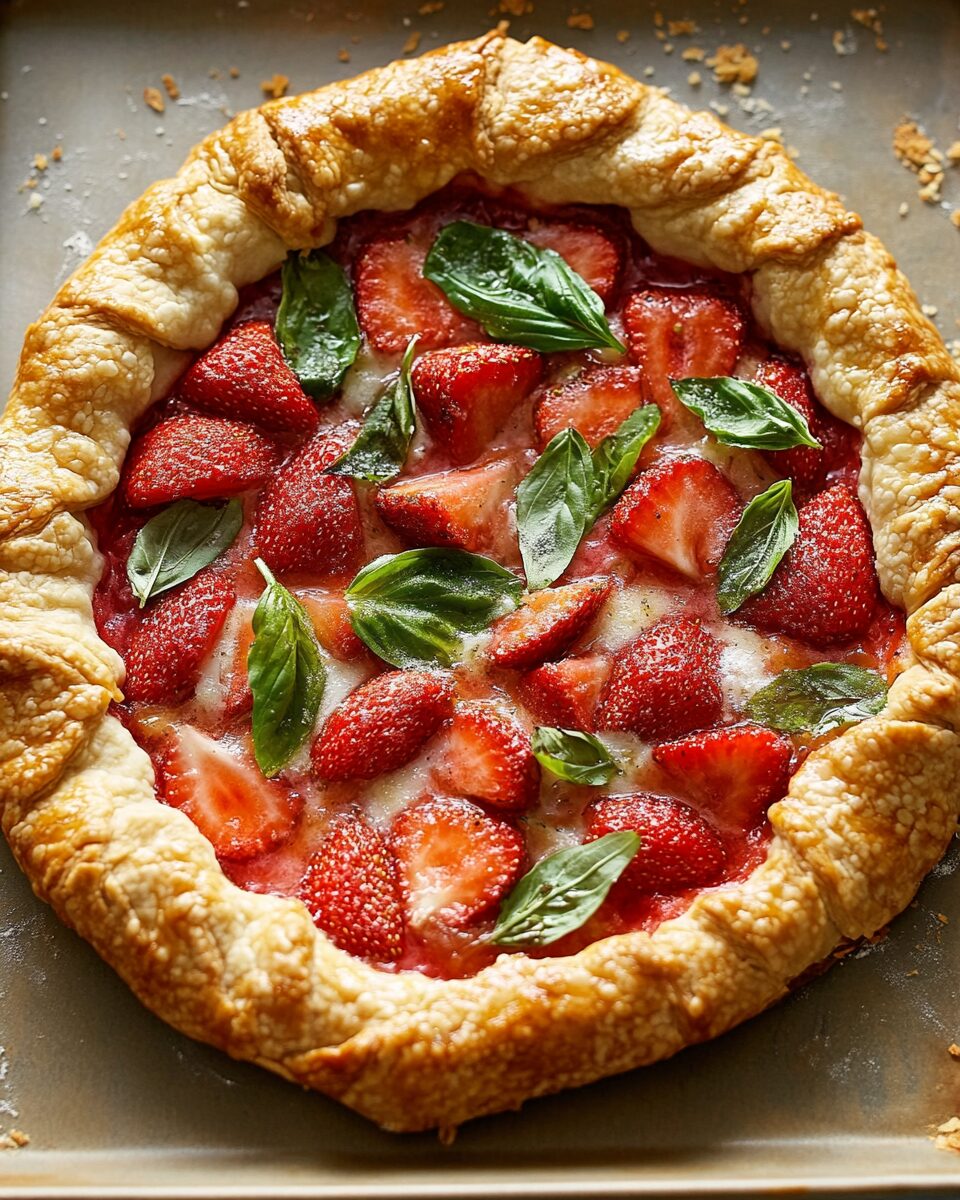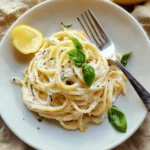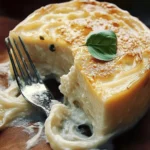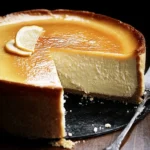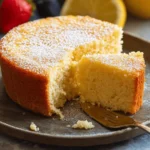A delightful blend of tart rhubarb and sweet rustic charm, this old-fashioned galette captures the warmth and simplicity of grandma’s kitchen. With a flaky, buttery crust and a perfectly balanced filling, this dessert is ideal for showcasing seasonal rhubarb in a homestyle way.
FULL RECIPE
Ingredients
- 1 1/4 cups all-purpose flour
- 1/2 teaspoon salt
- 1 tablespoon granulated sugar
- 1/2 cup unsalted butter, cold and cubed
- 3 to 4 tablespoons ice water
- 3 cups fresh rhubarb, chopped
- 1/2 cup granulated sugar (for filling)
- 2 tablespoons cornstarch
- 1 teaspoon vanilla extract
- 1 tablespoon lemon juice
- 1 tablespoon butter, cut into small pieces (for topping)
- 1 egg, beaten (for egg wash)
- 1 tablespoon coarse sugar (optional, for sprinkling)
Directions
- In a large bowl, mix flour, salt, and 1 tablespoon sugar.
- Cut in the cold butter using a pastry cutter or fork until the mixture resembles coarse crumbs.
- Add ice water gradually, mixing until dough comes together. Shape into a disk, wrap, and refrigerate for 30 minutes.
- Preheat oven to 400°F (200°C).
- In a separate bowl, combine rhubarb, 1/2 cup sugar, cornstarch, vanilla, and lemon juice. Mix well and set aside.
- Roll out the chilled dough on a lightly floured surface into a 12-inch circle. Transfer to a parchment-lined baking sheet.
- Spoon the rhubarb mixture into the center of the dough, leaving a 2-inch border.
- Fold the edges over the filling, pleating as needed. Dot the top with butter pieces.
- Brush the crust with beaten egg and sprinkle with coarse sugar if using.
- Bake for 35–40 minutes or until crust is golden and filling is bubbling.
- Cool slightly before serving.
Nutritional Information
- Calories: 240
- Fat: 13g
- Saturated Fat: 8g
- Carbohydrates: 30g
- Sugar: 15g
- Fiber: 2g
- Protein: 3g
The History of Rhubarb in Baking
Rhubarb has a long-standing history in baking, especially in traditional desserts from Europe and North America. Originally valued for its medicinal properties, rhubarb eventually found its place in kitchens as a tart, versatile ingredient. The use of rhubarb in galettes and pies became popular during the early 20th century when home bakers sought to utilize seasonal ingredients in simple yet flavorful ways. Its unique tanginess pairs perfectly with sweet elements, making it a classic in rustic-style desserts like this galette.
Why Use Rhubarb in a Galette?
Rhubarb’s natural tartness provides a delightful contrast to the sweetness in baked goods. In a galette, which is essentially a freeform tart, the rhubarb’s texture and flavor stand out without being overwhelmed by heavy creams or overly sugary fillings. The open-faced nature of the galette also allows the rhubarb to caramelize slightly, adding complexity to the dish.
The Charm of Rustic Baking
Rustic baking emphasizes simplicity and heartiness over precision and polish. This galette captures that ethos perfectly. The uneven edges and open top celebrate a more homemade, approachable aesthetic that invites everyone to enjoy. Rustic baking is often less intimidating for beginners and encourages creativity and adaptation.
The Role of the Buttery Crust
A flaky, buttery crust is essential to any successful galette. The butter creates layers of tender, flaky dough that contrast beautifully with the tender, slightly firm rhubarb filling. Using cold butter and minimal handling is key to achieving this texture, which gives the galette its signature richness and delicate crumb.
Balancing Tartness and Sweetness
One of the challenges in making rhubarb desserts is balancing its sharp acidity with sweetness. This galette achieves that balance by combining rhubarb with sugar and a thickening agent like cornstarch. The lemon juice enhances brightness without making the tartness overwhelming, resulting in a harmonious flavor profile.
Why Cornstarch is Important
Cornstarch is used as a thickening agent to help the rhubarb juices set during baking. Without it, the filling can become too runny and make the crust soggy. Cornstarch absorbs the liquid released by the rhubarb as it cooks, giving the filling a nice, gel-like consistency while maintaining the fruit’s fresh flavor.
The Importance of Chilling the Dough
Chilling the dough before rolling it out is crucial for a flaky crust. Cold dough prevents the butter from melting too quickly during baking, which creates the flaky layers. It also makes the dough easier to handle and reduces the risk of shrinking or tearing while shaping the galette.
Egg Wash for a Golden Finish
Brushing the crust with an egg wash before baking gives the galette a beautiful golden color and a slight sheen. It also helps the coarse sugar on top adhere and adds a subtle crunch. This finishing touch enhances both the appearance and texture of the galette.
Seasonality of Rhubarb
Rhubarb is a spring and early summer vegetable, prized for its tart stalks. Its seasonality means that this galette is often associated with warmer months and fresh, local ingredients. Using rhubarb in its peak season ensures the best flavor and texture for the dessert.
Health Benefits of Rhubarb
While rhubarb is mostly known for its tartness in desserts, it also contains dietary fiber, vitamins like K and C, and antioxidants. It is low in calories and can be a good addition to a balanced diet when consumed in moderation. However, the leaves are toxic and should never be eaten.
Variations to Try
This rustic rhubarb galette recipe is highly adaptable. You can experiment by adding strawberries, raspberries, or apples to the filling for extra flavor and sweetness. Spices like cinnamon, ginger, or nutmeg can also complement the tartness of rhubarb, adding warmth and complexity to the dessert.
Serving Suggestions
Rustic rhubarb galette is delicious served warm or at room temperature. It pairs beautifully with a scoop of vanilla ice cream, whipped cream, or even a dollop of crème fraîche. The creamy elements balance the tartness and add richness to each bite.
Storage and Reheating
Leftover galette can be stored covered in the refrigerator for up to three days. To reheat, warm it gently in the oven at a low temperature to preserve the crust’s flakiness. Avoid microwaving as it can make the crust soggy.
Tips for Working with Rhubarb
When preparing rhubarb, choose firm, bright stalks without blemishes. Trim the ends and peel if the skin feels tough. Cutting rhubarb into uniform pieces ensures even cooking. Since it is quite fibrous, cooking it properly softens the texture and releases its juices.
The Appeal of Open-Faced Pastries
Galettes and other open-faced pastries have gained popularity for their rustic appearance and straightforward preparation. Unlike traditional pies that require a top crust, galettes are quicker to assemble and have a charming, casual look that fits well with farmhouse or country-style dining.
Gluten-Free and Vegan Adaptations
For those with dietary restrictions, this galette can be modified. Gluten-free flours like almond or oat flour blends can replace all-purpose flour, though texture will vary slightly. Vegan substitutes for butter and egg wash, such as coconut oil and plant-based milk or aquafaba, can be used to keep the galette dairy-free and egg-free.
The Cultural Significance of Galettes
Galettes have their origins in French cuisine, particularly in Brittany. They represent an affordable, practical way of baking with seasonal fruits and simple dough. Over time, the rustic galette has become a symbol of home cooking and comfort food in many cultures worldwide.
Common Mistakes to Avoid
One frequent mistake is over-handling the dough, which can lead to a tough crust. Another is using too much liquid in the filling without a thickener, resulting in a soggy base. It’s also important not to over-bake, which can dry out both crust and filling.
Why This Recipe Feels Like Grandma’s
The term “grandma style” evokes warmth, nostalgia, and authenticity. This recipe embraces those qualities by focusing on simple ingredients, straightforward techniques, and a homey, unpretentious presentation. It’s the kind of dessert that brings people together and feels like a comforting tradition.
Pairing with Beverages
Rustic rhubarb galette pairs well with light, refreshing beverages like iced tea, lemonade, or a crisp white wine. The tartness of the rhubarb contrasts nicely with these drinks, making it a great choice for spring and summer gatherings.
Conclusion
Rustic rhubarb galette is more than just a dessert; it’s a celebration of seasonal ingredients, simple baking techniques, and nostalgic flavors. Its balance of tart rhubarb and buttery crust makes it a timeless treat that invites warmth and comfort. Whether you’re an experienced baker or a beginner, this galette offers a satisfying way to enjoy rhubarb’s unique qualities. The versatility of the recipe allows you to customize it to your taste or dietary needs, making it an enduring favorite for generations to come.

